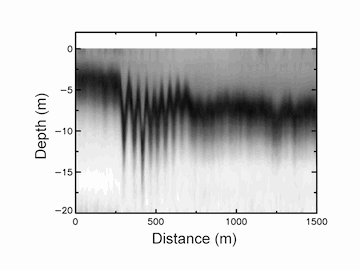340414-deep waves.gif

Graph of internal wave in the open ocean. Credit: National Oceanic and Atmospheric Administration
Waves as tall as skyscrapers ripple through the world’s oceans. They don’t come crashing ashore, though, because they travel across the ocean floor, not the surface. In fact, their effect on the surface is almost nil. But their effects on the deep ocean are critical.
Internal ocean waves are made possible by the fact that not all ocean water is the same. Water at the bottom is generally colder and denser than water near the surface.
Waves form when strong tides push the bottom layers over rugged terrain, across ridges, or through narrow channels. The waves rise into the less-dense waters above them, just as waves on the surface rise into the less-dense air.
Most of these waves are no more than a few dozen feet tall. But the biggest waves can be many hundreds of feet tall, and can stretch across hundreds of miles. The waves move much slower than waves on the surface, but they contain so much water that they’re quite powerful. Their relentless beat can shorten the lives of oil rigs and even endanger submarines.
They also appear to serve important functions for the oceans themselves. As the waves break, they create turbulence that mixes up different layers of water. That brings nutrients from the bottom up to the surface, supporting the entire marine food chain. And it may also transfer some of the heat from near the surface into the deep ocean. That helps regulate the temperature of both the ocean and the air, and stores some of the heat of our warming climate at the bottom of the oceans.

